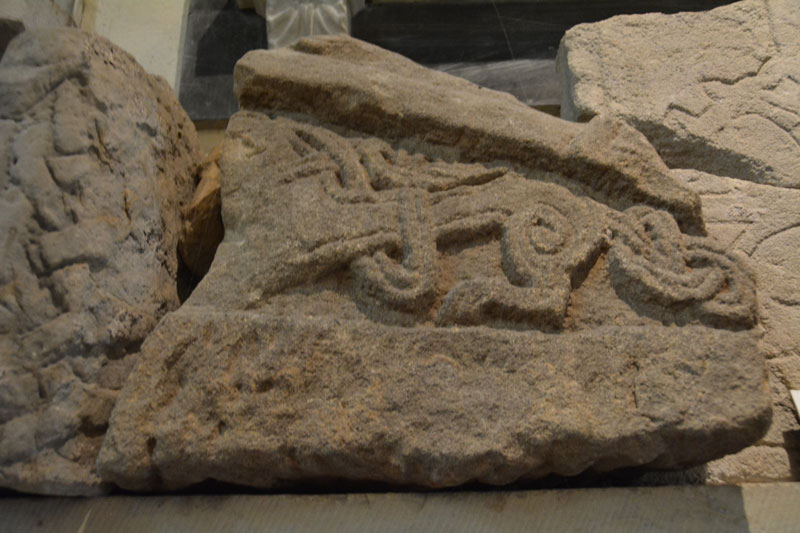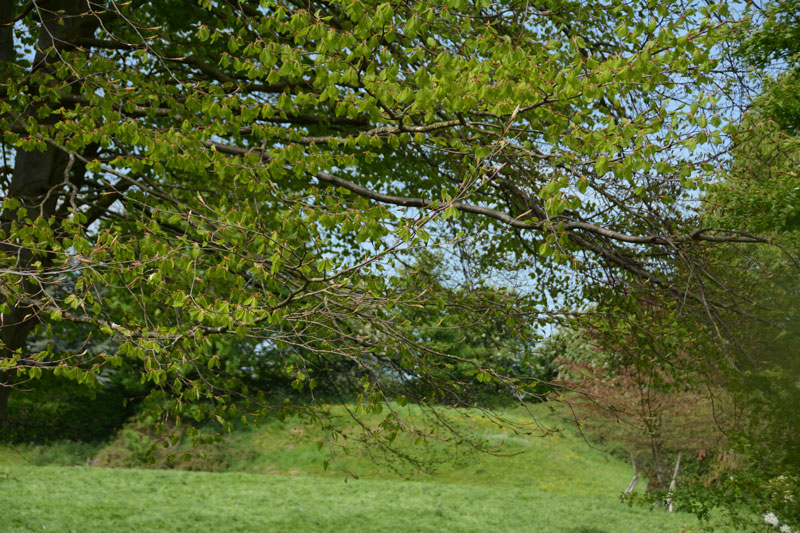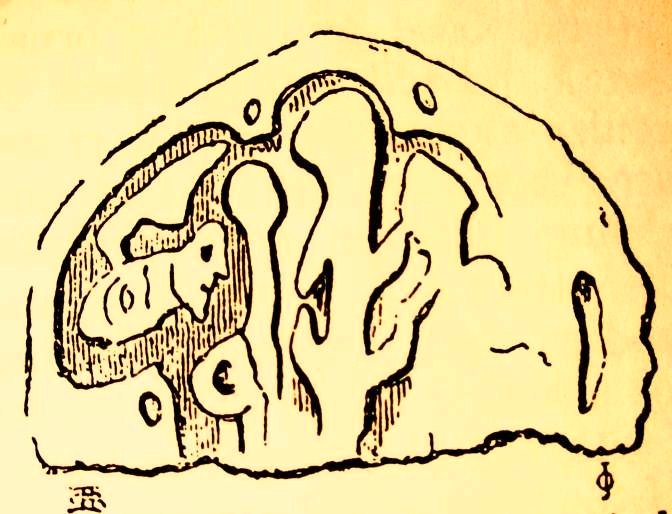Contributory members are able to log private notes and comments about each site
Sites Anne T has logged on trip number: 23 (View all trips)
View this log as a table or view the most recent logs from everyone
All Saints (Pickhill)
Trip No.23 Entry No.2 Date Added: 16th May 2017
Site Type: Ancient Cross
Country: England (Yorkshire (North))
Visited: Yes on 11th May 2017. My rating: Condition 3 Ambience 4 Access 5

All Saints (Pickhill) submitted by Anne T on 16th May 2017. This piece of hogback shows the remains of a monster with an elaborately knotted tail.
(View photo, vote or add a comment)
Log Text: Hogback and Cross Fragments, Pickhill, North Yorkshire: This church was recommended by ‘Rev Robbo’ (Reverend Ian Robinson) of St. Gregory’s, Bedale, who told us that there was a collection of fragments in the base of the tower. I’d sent an email to the vicar but received no reply, so phoned the number on ‘A Church Near You’ website. The church is open during the day.
The church really is in a lovely location. Going through the lych gate, I was greeted by a mounting block with what looked like an old cross shaft on top, but which was a sundial. On the south wall of the tower there is a very interesting carved beam from the 15th century depicting a hunting scene and a green man.
In the churchyard there are some interesting grave markers. Mentioned in the church guide are 3 markers mentioning the children of the White family, who all died tragically young. The guide also mentions to look out for the mound on which the Norman castle was built.
Money Hill (Pickhill)
Trip No.23 Entry No.3 Date Added: 16th May 2017
Site Type: Artificial Mound
Country: England (Yorkshire (North))
Visited: Yes on 11th May 2017. My rating: Condition 2 Ambience 3 Access 5

Money Hill (Pickhill) submitted by Anne T on 16th May 2017. The south eastern side of the motte rises about 3 metres high. Without the mentions on the OS map and the All Saints church guide, I would have driven straight past this scheduled ancient monument!
(View photo, vote or add a comment)
Log Text: Money Hill Motte, Pickhill: Leaving All Saints, going back down Money Hill to Street Lane, we stopped to look at the remains of the motte. I confess that without the grid reference and the OS map, I would have mistaken this for just another earthwork.
This is in fact a scheduled ancient monument, which was cut be the old railway line and the building of a bungalow. It is unusual in that it is square in shape.
Didn’t stop to wander round, as we were late for our appointment at St. Thomas’s, Brompton.
St Gregory's Church (Bedale)
Trip No.23 Entry No.1 Date Added: 14th May 2017
Site Type: Early Christian Sculptured Stone
Country: England (Yorkshire (North))
Visited: Yes on 11th May 2017. My rating: Condition 3 Ambience 4 Access 5

St Gregory's Church (Bedale) submitted by Sunny100 on 17th Aug 2010. Arched-shaped fragment of a 9th century Viking hogsback tombstone in the crypt of St Gregory's church, Bedale. The carving could depict Christ's crucifixion, or it could be The Tree of Life.
(View photo, vote or add a comment)
Log Text: Anglo-Danish stones, St. Gregory's, Bedale: We’d been to St. Gregory’s a long time ago, but the stone fragments had just been moved into the crypt at the advice of North Yorkshire Police because one stone had been stolen.
So as not to be disappointed this time, I’d been corresponding with ‘Rev Robb’ (Rev. Ian Robinson) to make an appointment to get into the crypt. At the time I’d last contacted him, it was just before Easter. He offered the date of 27th May, when a group was also visiting. I elected to leave it until he returned from holiday, and arranged 11th May, with us attending Holy Communion at 10am, staying on to look round the church and be shown the stones.
The parishioners made us very welcome indeed. After the service, Rev. Robinson came and introduced us and took us round to the crypt (which is on the outside of the church – I’d had visions of climbing down dusty, steep steps!), with a step down into the crypt, which is built under the altar in the sanctuary (note: later exploring the church, climbing up the steps to this altar, you are at least 6 to 8 feet above the congregation; it would not be good if you missed one of the steps!).
I gave Rev. Robinson a printout of the Portal page with the drawings. First of all he told me that since he’d been vicar here (for 6 years) there had only been the two stones – one had ‘gone missing’ and weren’t sure of it’s location (possibly Durham Cathedral?). He helped me identify the half torso. Because of the story associated with this stone, he was torn between keeping the stone because of it’s non-Christian origins vs being part of the church’s history.
The church guide says “A Viking myth tells of a man called Weland (pronounced Wayland), a highly skilled smith. He is captured by a king, who has his hamstrings cut to prevent him from escaping; but he escapes on a flying machine he has made. The caring on the stone …. Shows part of Welland on his machine. You can make out the fan shaped tail and one of the wings as well as his feet, legs and body bound together by Celtic knots. On the ned of the tombstone are the remains of a nativity scene ….. this is part of a hogback tombstone dating from the 10th century. In 2003 it was rediscovered in the crypt and has been identified as the Weland stone of which there are only three known examples in this country. The others are in Leeds Parish church and Sherburn Church, near Filey.”
The other stone “was part of a column or pillar, (and) is a good example of Anglian knotwork.”
Also in the crypt is a curious staircase which leads up to the side of the altar. We were told this was for the Chantry monks to go straight up to the main body of the church. There was also a small ‘arms column’ locked with three enormous, hand-made padlocks. In the vestry, there were numerous examples of chests locked with three keys (each needing a different key). There are five effigies; four at the west end of the nave, one in the vestry. The staircase to the bell tower had a portcullis (you can still see where it used to be raised up), and looking up into the tower there is a hatch; above this, the Reverend told us there was a room with a guard-robe and a fireplace.
St Thomas (Brompton)
Trip No.23 Entry No.4 Date Added: 16th May 2017
Site Type: Ancient Cross
Country: England (Yorkshire (North))
Visited: Yes on 11th May 2017. My rating: Condition 4 Ambience 4 Access 5

St Thomas (Brompton) submitted by Anne T on 16th May 2017. These three hogbacks are truly magnificent. Having been buried in the ground for so long, they look as if they have been carved recently. Well worth a visit just to see these, never mind the other cross fragments.
(View photo, vote or add a comment)
Log Text: Hogbacks and Crosses, Brompton, North Yorkshire: This is a visit I’d arranged some time ago, arranging to meet the church warden at 2pm on 11th May (details on the 'A Church Near You' website). The church is kept locked, as we found out when we’d tried to visit a couple of years ago, and I was much looking forward to this return visit.
We were a little late, having stopped to photograph the remains of the motte at Pickill, and having hit a little traffic in Northallerton, but we found the church wardens sweeping up cherry blossom from the porch of the church. We were certainly made very welcome.
There are three complete hogbacks, the carving of which is very crisp, almost as if they had been done yesterday – preserved after having been buried in the ground for so long.
A further two fragments sit, almost hidden, against the north eastern corner of the nave, wedged between an altar, some heating pipes and the wall.
Sitting to the south of these, against the boundary between the nave and the chancel, was a wheel head cross. Another cross sat on the south wall of the chancel, with a further 3 sitting on the southern window ledge of the western wall.
The Cock Shaft sits almost hidden at the back of the pews, in the south west corner of the church, and is named so because there are three cocks on the southern face.
To my surprise, Doreen said there were three further fragments in the external south and east walls of the church, so we hunted for these whilst she spoke to the man repairing the churchyard wall. There are also the remains of a grave marker, now broken in two, placed in separate parts high up on the eastern wall.
We were given the ‘Village Trail’ and also told much interesting history about the linen factories in the village, and started off on the walk to see the village green, Cockpit Hill and the water splash. A great day out.
